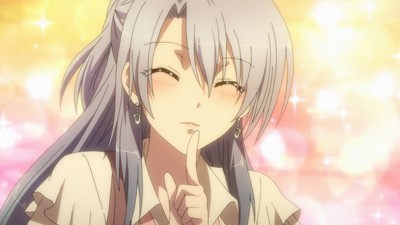Science Fell in Love, So I Tried to Prove it
Episode 6
by Richard Eisenbeis,
How would you rate episode 6 of
Science Fell in Love, So I Tried to Prove It ?
Community score: 4.6
 In which we successfully break down what makes a romantic atmosphere.
In which we successfully break down what makes a romantic atmosphere.
Episode 6 of Science Fell in Love, So I Tried to Prove It, is easily the series' best single stand-alone episode so far. While there is nothing new in the way of characters or storytelling structure, it is the perfect application of the formula the show has set up and refined until now.
This episode is centered around Yukimura and Himuro's first kiss--but that's not what it's really about. As the two get ready for their first kiss—measuring the angles for maximum lip contact while all the other lab members look on—Himuro decides that she just isn't feeling it. While Yukimura is shocked, the others explain to him the idea of a romantic mood. And while he, at first, finds it hard to understand, through a few choice examples, he sees that mood truly is important.
The first half of the episode revolves around our characters trying to answer one simple question: What makes a romantic mood? Of course, while the question is simple, the answer is anything but—and that's what makes it so interesting. Everyone has their own unspoken idea of what makes a romantic atmosphere but actually breaking it down into common pieces that apply to the vast majority of people is something most of us have never thought about.
The variables they come up with are pretty much spot on by anyone's standards:
• Beauty of surroundings
• Lack of people in surroundings
• Dimness
• Quietness
• Length of time spent silently gazing at each other
But then, the anime takes it one step further, showing through complex formulas (that I couldn't begin to understand) how each relates to each other—and at which point each overrides the others and completely destroys the mood. It makes me truly believe that something like a romantic atmosphere can be quantified—which is needed for the second half of the episode to work.
The second half puts all that we've learned so far into action as the team has found the most romantic place on campus—the roof of one of the buildings at sunset. But before Yukimura and Himuro can kiss, they need to get control samples from those clearly not in love with each other. This means we get each possible combination of our five lab members having to kiss each other.
In doing so, we learn a bit about each character and how they relate to each other—especially those who don't often interact together. Himuro and Kanade have a sisterly relationship while Inukai and Yukimura feed off each others “manliness” to pump themselves up. Meanwhile, Inukai and Kanade see each other as fellow strangers in a strange world. And Ibarada, she just wants to mess with everyone—no matter the person.
And, of course, everything goes completely pear-shaped when Yukimuro and Himuro get their turn as one factor after another destroys the mood before somehow finishing off with a scene so scientifically romantic it blows Himuro's mind.
Overall, this episode's funny, full of heart, and actually teaches something; it is a great example of what the show is like at its best.
Rating:
Little Things I Loved:
• How angry and worried both Himuro and Yukimura get about the other kissing another person. Perhaps they should be trying to prove jealousy instead of love. They might just prove they're in love with each other as a byproduct.
• Ibarada just straight up kisses Himuro with no issue—and when she's told that girls don't regularly kiss each other on the lips in a platonic way, she simply shrugs it off. The girl feels no embarrassment and no shame.
• The romantic mood gauge is almost as good as the “what I'm thinking” pop-ups from the date episode.
• We never seen the scene where Inukai has to kiss Ibarada's feet but there's a photo of it post-credits.
• The after credits stinger is a great joke that calls back to the previously pointed out flaw in their past experiments—a flaw that only Ibarada seemed to remember. There are a lot of reasons why a person's heart rate could increase besides romantic interest.
Science Fell in Love, So I Tried to Prove It is currently streaming on Crunchyroll.
Richard is an anime and video game journalist with over a decade of experience living and working in Japan. For more of his writings, check out his Twitter and blog.
discuss this in the forum (31 posts) |
back to Science Fell in Love, So I Tried to Prove it
Episode Review homepage / archives